How ‘green’ hydropower projects fuel displacement and injustice
Globally, the hydropower industry has undergone a public relations transformation, now branding itself as a champion of climate resilience. But as the Costa Rican case illustrates, hydropower’s green image often masks extractive practices that deepen inequalities, disrupt ecosystems, and marginalize vulnerable populations. The study identifies these dynamics as examples of “green extractivism”, where environmental rhetoric is weaponized to justify projects that replicate the harms of earlier forms of development.

A compelling new analysis calls into question the long-standing image of hydropower as a clean energy solution. A study published in Water (2025) titled “Making Sense of Unsustainable Realities: Hydropower and the Sustainable Development Goals” by Emily Benton Hite presents a searing critique of hydropower’s role in achieving sustainability. Drawing on multi-sited ethnographic research in Costa Rica, particularly among the Brörán Indigenous peoples, the study shows how the Diquís hydropower project, once touted as central to Costa Rica’s carbon neutrality ambitions, reflects deep tensions between global climate objectives and local justice, autonomy, and environmental health.
Although hydropower is frequently promoted for addressing Sustainable Development Goals (SDGs) related to clean energy, climate action, and economic growth, the study argues it often worsens poverty, displaces communities, threatens biodiversity, and bypasses Indigenous consent. It suggests that the sustainability framework used to promote such projects conceals contradictions and reproduces the very injustices it aims to solve.
Who defines sustainable development and for whom?
The study examines a key question: for whom is hydropower sustainable? In the case of Costa Rica’s proposed Diquís Dam, the largest ever conceived in Central America, the answer reveals stark disparities. The project, developed by the Instituto Costarricense de Electricidad (ICE), was positioned as the linchpin of Costa Rica’s plan to achieve carbon neutrality by 2021. It was expected to generate 650 megawatts of electricity, enough to power a million homes, and was framed as a vital step toward achieving SDG 7 (affordable and clean energy), SDG 8 (economic growth), and SDG 13 (climate action).
However, the benefits promised to the nation came with heavy costs for the Brörán people. The proposed dam site on the Térraba River would have affected seven autonomous Indigenous territories and directly impacted more than 15,000 Indigenous people. It threatened to submerge farmland, disrupt ecosystems, and sever the cultural and spiritual ties that Indigenous communities have with the river. Despite the magnitude of these impacts, the state failed to obtain Free, Prior, and Informed Consent (FPIC), violating both international conventions and Costa Rica’s own legal commitments.
Fieldwork reveals that many Brörán community members fundamentally reject the developmental ideology that prioritizes large-scale infrastructure over collective well-being and environmental harmony. The river is considered sacred and essential to Brörán identity and livelihood. Community members repeatedly emphasized that true development must be rooted in self-determination, mutual care, and environmental stewardship, not imposed through capitalist extraction.
What are the trade-offs and who decides them?
The study exposes how the social and ecological trade-offs of hydropower are overwhelmingly borne by Indigenous communities, while the benefits are often exported elsewhere, both figuratively and literally. While ICE framed Diquís as a project that would bring jobs, tourism, and progress to the region, Indigenous residents feared displacement, environmental degradation, and cultural erosion. As documented in interviews, promises of employment and infrastructure were vague or inequitable; skilled labor positions were usually given to outsiders, and the few roles offered to Indigenous women were menial or inappropriate under local customs.
Violence against Indigenous leaders who resisted the project, including the assassination of activist Jerhy Rivera, underscored the perilous reality of dissent. Community members were subjected to intimidation by non-Indigenous settlers who supported the project and stood to gain from the reservoir’s construction. These incidents highlight how hydropower developments often inflame existing land conflicts and exacerbate ethnic tensions, directly conflicting with SDG 16 (peace, justice, and strong institutions).
The study also critiques the sustainability metrics employed by institutions like the International Hydropower Association (IHA), which developed a Hydropower Sustainability Assessment Protocol to evaluate project impacts. However, these frameworks are largely voluntary, not legally binding, and exclude vital elements such as cultural valuation and Indigenous epistemologies. The IHA’s vision of sustainability emphasizes economic efficiency and technical feasibility, neglecting the broader questions of justice and legitimacy raised by affected communities.
Are global sustainability goals enabling green injustice?
By examining hydropower through the lens of hydrosocial territories, frameworks that recognize the entanglement of water governance with societal and ecological relationships, the study shows how national and global sustainability strategies can be deeply unjust. Hydropower’s inclusion in the SDG framework and global climate agreements (such as the Kyoto Protocol) has elevated it as a solution, despite decades of warnings about its adverse social and environmental consequences.
In the case of Costa Rica, Diquís was eventually canceled in 2018, citing economic concerns and overproduction. Yet, as the study warns, the threat remains alive: a resurgence of the project is being considered by the current administration. For the Brörán, the cancellation brought no lasting security, there was no legally binding agreement ensuring that development would respect their rights in the future.
Globally, the hydropower industry has undergone a public relations transformation, now branding itself as a champion of climate resilience. But as the Costa Rican case illustrates, hydropower’s green image often masks extractive practices that deepen inequalities, disrupt ecosystems, and marginalize vulnerable populations. The study identifies these dynamics as examples of “green extractivism”, where environmental rhetoric is weaponized to justify projects that replicate the harms of earlier forms of development.
The author urges a transition from centralized, large-scale hydropower toward decentralized, community-driven energy systems. She calls for energy transitions that embed Indigenous knowledge, cultural values, and social justice principles, what scholars refer to as “post-neoliberal environmental governance.” Latin America, where social movements are increasingly shaping climate debates, offers alternative frameworks such as buen vivir (living well) and the rights of nature.
- FIRST PUBLISHED IN:
- Devdiscourse










